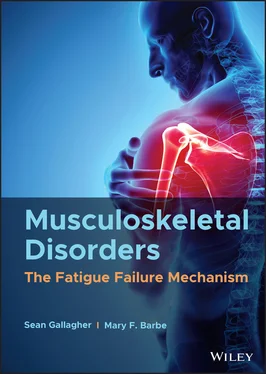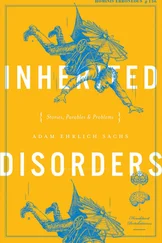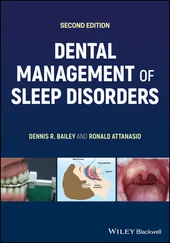Sean Gallagher - Musculoskeletal Disorders
Здесь есть возможность читать онлайн «Sean Gallagher - Musculoskeletal Disorders» — ознакомительный отрывок электронной книги совершенно бесплатно, а после прочтения отрывка купить полную версию. В некоторых случаях можно слушать аудио, скачать через торрент в формате fb2 и присутствует краткое содержание. Жанр: unrecognised, на английском языке. Описание произведения, (предисловие) а так же отзывы посетителей доступны на портале библиотеки ЛибКат.
- Название:Musculoskeletal Disorders
- Автор:
- Жанр:
- Год:неизвестен
- ISBN:нет данных
- Рейтинг книги:5 / 5. Голосов: 1
-
Избранное:Добавить в избранное
- Отзывы:
-
Ваша оценка:
- 100
- 1
- 2
- 3
- 4
- 5
Musculoskeletal Disorders: краткое содержание, описание и аннотация
Предлагаем к чтению аннотацию, описание, краткое содержание или предисловие (зависит от того, что написал сам автор книги «Musculoskeletal Disorders»). Если вы не нашли необходимую информацию о книге — напишите в комментариях, мы постараемся отыскать её.
Hands-on guidance and tools for the prevention of musculoskeletal injuries in the workplace Musculoskeletal Disorders: The Fatigue Failure Mechanism,
Musculoskeletal Disorders: The Fatigue Failure Mechanism
Musculoskeletal Disorders — читать онлайн ознакомительный отрывок
Ниже представлен текст книги, разбитый по страницам. Система сохранения места последней прочитанной страницы, позволяет с удобством читать онлайн бесплатно книгу «Musculoskeletal Disorders», без необходимости каждый раз заново искать на чём Вы остановились. Поставьте закладку, и сможете в любой момент перейти на страницу, на которой закончили чтение.
Интервал:
Закладка:
Over the past few decades, numerous methods have been developed to assess the risk of developing various types of MSDs. Some of the more popular methods include the National Institute for Occupational Safety and Health (NIOSH) Lifting Equation (Waters, Putz‐Anderson, Garg, & Fine, 1993), The Liberty Mutual Psychophysical tables (Potvin, Ciriello, Snook, Maynard, & Brogmus, 2021; Snook, 1978; Snook & Ciriello, 1991), The Strain Index (Moore & Garg, 1995), and the Threshold Limit Value for Hand Activity (Rempel, 2018). These methods are discussed in greater detail in Chapter 8. As discussed in that chapter, these MSD models have been validated against MSD prevalence and incidence in several epidemiology studies and have provided much knowledge in terms of improving the risk assessment of MSDs. These risk assessment tools have unquestionably aided in the prevention of untold injuries and disability in workers.
Despite the benefits of these methods, however, there appears much to be gained in applying fatigue failure principles to assess MSD risk. As will be discussed in this book, there are many validated fatigue failure techniques that provide ready solutions to challenging problems that have long been faced by musculoskeletal researchers. The following text provides some of the benefits of applying fatigue failure methods to MSD risk assessment.
Validated Methods of Cumulative Exposure Assessment. It has been a general assumption of musculoskeletal researchers that it is the totality of exposure that an individual experiences (often involving exposure to several tasks with highly variable loading profiles) that determines the risk of developing MSDs. However, not all current models provide methods of combining the risk associated with the performance of multiple tasks during a workday. Fortunately, the fatigue failure theory has validated methods for assessing the cumulative effects associated with highly variable loading histories, as might be experienced in multitask jobs (Miner, 1945; Palmgren, 1924). This technique (described in detail in Chapter 9) not only allows assessment of the cumulative effects of loading but can also evaluate the proportion of risk associated with each individual task. This provides the ability to identify work tasks most responsible for the overall risk (and most in need of ergonomic intervention). These cumulative exposure techniques have been shown to correlate well with MSD outcomes in fatigue failure‐based risk assessment tools (Gallagher, Sesek, Schall Jr, & Huangfu, 2017; Bani Hani et al., 2021; Gallagher, Schall Jr, Sesek, & Huangfu, 2018).
Biomechanics and Injury Risk. Biomechanical analysis is an important method of evaluating the forces and moments acting on the body due to the performance of physically demanding tasks. However, while this technique allows for the quantification of stresses on the musculoskeletal system, the relationship of calculated forces and moments to actual injury risk has often been missing. For example, a traditional introductory biomechanical problem asks the student to calculate the force required of the elbow flexor muscles to hold a certain load in the hands. For example, it might be calculated that holding a 11.3 kg (25 lbs) weight, the upper arm perpendicular to the floor, and the elbow flexed at 90° require an elbow flexor muscle force of approximately 1,000 N (225 lbs). It is, of course, interesting in itself that the muscle forces required are vastly greater than the load being held. But what if we are interested in estimating the probability of an injury outcome to the elbow flexor tendons if such a load was handled 100 times in a workday? And what if this task were combined with another where 500 repetitions of handling a load of 5 kg (11.0 lbs.) in the same posture? Biomechanical modeling techniques alone cannot answer these questions. However, when used in conjunction with fatigue failure techniques, one can use biomechanical estimates of tissue stress to estimate injury probabilities associated with either mono‐task jobs or combinations of tasks. Chapter 5discusses the benefits of applying fatigue failure principles to biomechanical analyses to help estimate the fatigue life of tissues experiencing repeated biomechanical stress.
Damage versus Healing. As indicated earlier, musculoskeletal health is expected to be dependent upon both damage development (due to repeated stress) and healing. As noted long ago by Nash, despite the additional complexity of the presence of a healing component, it is relatively easy to develop an injury model that incorporates both cumulative damage development and healing using a fatigue failure approach (Nash, 1966). This simply involves use of the Palmgren–Miner method ( Chapter 9) to ascertain the cumulative damage associated with the experienced variable magnitude loading, and then subtracting out the damage healed over the same time frame. If the rate of cumulative damage is greater than the healing rate, damage will occur; in contrast, if the healing rate equals or exceeds the rate of damage development, no damage would be expected to occur. This model can also be employed to assess risk in conditions associated with impaired healing (such as psychological stress, aging, and obesity), as discussed in Chapter 10. Thus, in contrast to previous models, fatigue failure techniques are well positioned to address important complexities of the biological environment that are important in maintaining musculoskeletal health. This “damage and healing” model may be useful, for example, in assessing the MSD risk associated with factors known to impair the healing process, such as psychological stress, obesity, and aging (Guo & DiPietro, 2010). These and other implications are discussed further in Chapter 10.
Real‐Time Risk Assessment. The fatigue failure theory also has techniques that could be used as real‐time exposure assessment methods continue to develop and mature (Radwin, 2011). Due to the variable amplitude loading histories experienced by humans in the performance of physical work, a method will be needed to evaluate the risk associated with complex and irregular loading curves. Fortunately, this situation is also encountered in the loading of other materials and methods have been developed to deconstruct complex loading curves into cycles that can then be assessed by fatigue failure models. The consensus technique is known as rainflow analysis (Matsuishi & Endo, 1968). This technique evaluates stress “reversals” (half‐cycles) associated with complex loading histories and derives full cycles for analysis while accounting for the entire load history (Chapter 9). Thus, the fatigue failure approach is well positioned for the future of risk assessment in which complex loading curves derived from real‐time exposure assessment can be rapidly analyzed using validated techniques as discussed further in Chapter 13.
Cumulative Risk from Different Loading Modalities. Fatigue failure methods also hold the promise of combining the risks associated with diverse loading modalities. For example, imagine a delivery driver who experiences whole‐body vibration from driving across rough roads and then must carry heavy boxes to complete the delivery. Fatigue failure methods hold the promise to combine these two types of repetitive stress into a single measure of risk and provide an estimate of cumulative damage associated with both exposures. Whole‐body vibration is known to be an exposure that imposes repeated stress on the low back (Gallagher & Schall, 2017) as does repetitive compressive loading due to lifting (Brinckmann, Biggemann, & Hilweg, 1988). Since both can be expressed in terms of cumulative damage, fatigue failure techniques could be used to combine these disparate loading modalities to obtain a cumulative measure of overall risk not previously available (Chapter 9).
Combining Static and Cyclic Loading. MSDs may also be the result of both static and/or dynamic activities. Thus, it would be helpful to have a method of calculating the combined risk associated with a combination of creep (static) loading and cyclic (dynamic) loading. Fortunately, the fatigue failure theory also has a validated method of evaluating the cumulative effects associated with combined static and dynamic loading (Wright, Carroll, Sham, Lybeck, & Wright, 2016). This method allows estimating the proportion of risk associated with dynamic versus static loads overall, as well as the proportion of individual task risks for both types of loading (See Chapters 9 and 13).
Читать дальшеИнтервал:
Закладка:
Похожие книги на «Musculoskeletal Disorders»
Представляем Вашему вниманию похожие книги на «Musculoskeletal Disorders» списком для выбора. Мы отобрали схожую по названию и смыслу литературу в надежде предоставить читателям больше вариантов отыскать новые, интересные, ещё непрочитанные произведения.
Обсуждение, отзывы о книге «Musculoskeletal Disorders» и просто собственные мнения читателей. Оставьте ваши комментарии, напишите, что Вы думаете о произведении, его смысле или главных героях. Укажите что конкретно понравилось, а что нет, и почему Вы так считаете.




![Ally Carter - [Gallagher Girls 02 ] - Cross My Heart & Hope To Spy](/books/262178/ally-carter-gallagher-girls-02-thumb.webp)







![John Bruce - The Lettsomian Lectures on Diseases and Disorders of the Heart and Arteries in Middle and Advanced Life [1900-1901]](/books/749387/john-bruce-the-lettsomian-lectures-on-diseases-and-disorders-of-the-heart-and-arteries-in-middle-and-advanced-life-1900-1901-thumb.webp)